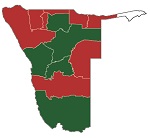On the move again
Namibia is currently witnessing a major transformation of its society, economy and demography, which is largely brought about by the large-scale migration of people from rural farms and villages to towns and cities. Soon, even more people will be living far from where they or their parents or grandparents were born. For many the movements will be permanent, but others will return to their roots to retire or to lead a life simpler than that of urban hustle and bustle.
9.11 Regional migration gains or losses, 201122


In 2011, Khomas and Erongo had many more residents than were born in these two regions. Smaller gains were made in ǁKharas, Otjozondjupa and Oshikoto, while Ohangwena, Omusati and Hardap lost the greatest proportions of people that had been born there. These figures are growth rates, expressed as the change in population per hundred people born in each region. For example, 21 of every 100 people born in Ohangwena had left the region, while Khomas acquired 75 people for every 100 people born in Khomas.
While the numbers in the graph are for each region, they largely reflect the presence or absence of substantial urban and economic centres. Thus, migrants to Khomas and Erongo were mainly attracted to Windhoek, Walvis Bay and Swakopmund where large urban centres with economic activities were present, while Omusati and Ohangwena both had small urban and economic centres in 2011.
9.12 Proportions of females and males no longer living where they were born, 201123

In 2011, more than half of all Namibians aged 25–59 years no longer lived where they were born, with somewhat more men having left their birthplaces than women. By the age of 60, the proportion of migrants decreased, perhaps because fewer people had migrated years ago when they were younger or because they had returned to retire in their original home villages and towns.

Photo: S Rankl
Nothing better reflects the mobility and adaptability of Namibians than the great many people living in the Namib Desert outside Swakopmund, many of them living in the township of DRC, which was founded in 2001.

